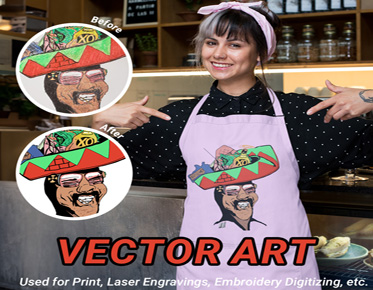The Truth About Digitizing Embroidery Punching
The intersection of digitizing and punching lies in their shared goal: transforming designs into embroidery-ready formats. While traditional punching involves physical templates, digitizing leverages technology to create digital equivalents. This shift from tangible punch cards to digital files enables more efficient design processes and opens up new possibilities for design complexity and customization. Understanding how these two methods complement each other can provide insights into their evolving roles in embroidery.
Understanding Embroidery Punching
The Traditional Punching Process: From Paper to Fabric
In traditional embroidery punching, the process begins with creating a detailed design on paper, which is then converted into a punch card or template. Each punch or hole in the card corresponds to a specific stitch or movement of the embroidery machine. The punched card guides the machine in stitching the design onto the fabric, ensuring that the pattern is accurately replicated. This manual method, while effective, requires considerable skill and time to produce detailed and consistent results.
Key Techniques in Embroidery Punching: Manual and Machine Methods
Embroidery punching can be carried out manually or with the aid of machines. Manual punching involves handcrafting templates or cards, often using tools to create precise holes or cuts. Machine methods, on the other hand, use specialized equipment to automate the punching process, allowing for quicker production and greater accuracy. Both methods have their advantages and are chosen based on the complexity of the design and the scale of production.
The Importance of Punching in Embroidery Design
Punching plays a crucial role in embroidery design by translating artistic concepts into practical stitch patterns. The accuracy of the punch card directly impacts the quality of the embroidery, as any discrepancies between the design and the card can result in errors or inconsistencies in the final product. Effective punching ensures that the design is faithfully represented, preserving the artist's vision and maintaining high standards of craftsmanship.
What Does Digitizing Embroidery Mean?
The Basics of Digitizing: Converting Designs into Machine-Readable Formats
Digitizing embroidery involves converting traditional designs into digital files that embroidery machines can understand. This process typically starts with scanning or importing a design into digitizing software, where it is then transformed into a machine-readable format, such as DST or PES. The software assigns stitch types, directions, and other parameters, enabling the embroidery machine to recreate the design accurately on fabric. This digital approach offers precision and flexibility, streamlining the design-to-stitch process.
Software Used in Digitizing Embroidery Designs
A variety of software programs are available for digitizing embroidery designs, each offering different features and capabilities. Popular options include Wilcom, Hatch, and Brother's PE-Design. These programs allow users to create and edit designs, convert images into embroidery-ready formats, and preview how the design will appear once stitched. Choosing the right software depends on factors such as design complexity, budget, and the specific needs of the embroidery project.
How Digitizing Enhances Precision and Efficiency
Digitizing enhances both precision and efficiency in embroidery by providing tools for exact design translation and reducing manual errors. Digital files allow for precise control over stitch placement, type, and density, resulting in high-quality embroidery. Additionally, the ability to easily modify and save designs digitally speeds up the production process and facilitates easy adjustments, making it an invaluable tool for both individual crafters and large-scale manufacturers.
The Possibility of Digitizing Embroidery Punching
Can Traditional Punching Techniques Be Digitized?
Yes, traditional punching techniques can be digitized. By scanning or photographing punch cards and converting them into digital formats, the essence of traditional punching can be preserved in a modern context. This process involves translating physical punch designs into digital files that embroidery machines can interpret, maintaining the integrity of the original design while leveraging the advantages of digital technology.
How Modern Technology Bridges the Gap Between Punching and Digitizing
Modern technology bridges the gap between traditional punching and digitizing through advanced scanning and conversion methods. High-resolution scanners and specialized software can capture the details of punch cards and translate them into digital formats. This integration allows designers to blend traditional techniques with contemporary technology, offering a hybrid approach that combines the craftsmanship of punching with the precision and efficiency of digitizing.
Benefits of Integrating Punching Techniques into Digitized Designs
Integrating traditional punching techniques into digitized designs offers several benefits. It allows designers to preserve the unique characteristics of classic punch designs while taking advantage of digital tools for enhanced precision and flexibility. This hybrid approach can result in a richer, more diverse range of designs, combining the best aspects of both traditional and modern methods to create exceptional embroidery.
Techniques for Digitizing Embroidery Punching
Scanning and Digitizing Punch Cards: A Step-by-Step Guide
1. Prepare the Punch Card: Ensure the punch card is clean and free of debris. If it's damaged, repair it as necessary to ensure accurate scanning.
2. Scan the Punch Card: Use a high-resolution scanner to capture the details of the punch card. Ensure the scan is clear and accurately represents the card’s features.
3. Import into Software: Load the scanned image into digitizing software. Use tools within the software to trace and convert the punch card into a digital embroidery file.
4. Adjust and Fine-Tune: Refine the digital design by adjusting stitch types, densities, and other parameters to ensure it aligns with the original punch card’s design.
Converting Physical Punch Designs into Digital Formats
Converting physical punch designs into digital formats involves several steps. First, create a high-quality scan or photograph of the punch design. Next, use digitizing software to trace the design and assign appropriate stitch settings. Finally, save the converted file in a format compatible with embroidery machines. This process ensures that the physical punch design is accurately represented in a digital format, ready for modern embroidery applications.
Using Vector Art in Digitized Punch Designs
Vector art can be a valuable tool in digitizing punch designs. By converting punch designs into vector format, designers can achieve greater precision and scalability. Vector art allows for easy manipulation of design elements, ensuring that the final embroidery design is accurate and visually appealing. Incorporating vector art into the digitization process enhances the quality and versatility of the final embroidery output.
Challenges in Digitizing Embroidery Punching
Accuracy and Detail: Preserving Punching Characteristics Digitally
Preserving the accuracy and detail of traditional punch designs in a digital format can be challenging. The transition from physical punch cards to digital files may result in the loss of some fine details or characteristics. To address this, designers must carefully adjust and refine digital designs to maintain the integrity of the original punch design, ensuring that every nuance is accurately represented.
Handling Complex Designs: Limitations of Current Technology
Current technology has limitations when handling highly complex punch designs. Intricate patterns or detailed designs may not always translate perfectly into digital formats, potentially leading to issues with stitch accuracy or design clarity. Designers should be aware of these limitations and consider simplifying or adjusting complex designs to ensure they can be effectively digitized and embroidered.
Ensuring Compatibility with Different Embroidery Machines
Ensuring that digitized designs are compatible with various embroidery machines can be a challenge. Different machines may require specific file formats or have unique stitching capabilities. Designers must verify that their digitized designs are compatible with the intended embroidery machines, making any necessary adjustments to ensure smooth operation and high-quality results.
Tools and Software for Digitizing Punching Designs
Overview of Popular Embroidery Digitizing Software
Several embroidery digitizing software programs are available, each offering unique features and capabilities. Notable options include:
● Wilcom Embroidery Studio: Known for its robust design tools and versatility.
● Hatch Embroidery Software: Offers intuitive design features and user-friendly interfaces.
● Brother PE-Design: Tailored for Brother embroidery machines, providing comprehensive digitizing solutions.
These programs provide essential tools for converting and refining designs, facilitating a seamless transition from traditional punching to digital formats.
Tools for Scanning and Converting Punch Designs
Scanning tools and software are crucial for converting punch designs into digital formats. High-resolution scanners capture detailed images of punch cards, while software like Adobe Photoshop or specialized digitizing programs can trace and refine these images. Utilizing the right tools ensures accurate and high-quality conversions, preserving the essence of traditional punch designs.
Evaluating Software Features for Punch-to-Digital Conversion
When evaluating software for punch-to-digital conversion, consider features such as:
● Precision and Accuracy: Ensure the software can accurately translate punch designs into digital formats.
● Editing Capabilities: Look for tools that allow detailed adjustments and refinements.
● Compatibility: Verify that the software supports various file formats and integrates with different embroidery machines.
Choosing software with these features will enhance the digitization process and ensure high-quality results.
Best Practices for Digitizing Embroidery Punching
How to Prepare Punch Designs for Digitization
Preparing punch designs for digitization involves several steps:
1. Clean the Design: Ensure the punch card or design is in good condition and free of damage.
2. Scan or Photograph: Use high-quality equipment to capture the design accurately.
3. Select Software: Choose appropriate digitizing software based on your needs and the complexity of the design.
Proper preparation ensures that the digitization process goes smoothly and the final digital design accurately reflects the original punch design.
Tips for Maintaining Design Integrity During Digitization
To maintain design integrity during digitization:
● Check for Accuracy: Regularly compare the digital design with the original punch card to ensure accuracy.
● Adjust Parameters: Refine stitch settings and other parameters to match the original design.
● Test the Design: Run test stitches to verify that the digital design translates well to fabric.
These practices help preserve the quality and accuracy of the original punch design.
Avoiding Common Pitfalls in Digitizing Punching Designs
Common pitfalls in digitizing punching designs include:
● Loss of Detail: Ensure that intricate details are preserved during conversion.
● File Compatibility Issues: Verify that the digital files are compatible with the intended embroidery machines.
● Overcomplication: Avoid excessive complexity that can hinder the digitization process.
Being aware of these pitfalls and taking steps to address them will lead to more successful digitization outcomes.
Comparing Digitized and Traditional Punching
Pros and Cons of Digitizing Punch Designs vs. Manual Punching
Digitizing Punch Designs:
● Pros: Greater precision, ease of modification, and faster production.
● Cons: Requires investment in software and technology, potential loss of traditional craftsmanship.
Manual Punching:
● Pros: Preserves traditional techniques, and offers hands-on control over design.
● Cons: Time-consuming, less flexible, and limited by manual skill.
Evaluating these pros and cons helps determine the best approach for embroidery projects.
How Digital Techniques Improve or Alter Traditional Embroidery
Digital techniques enhance traditional embroidery by offering improved precision, efficiency, and flexibility. While they may alter some conventional practices, they also provide new opportunities for design complexity and customization. Embracing digital methods can lead to innovative and high-quality embroidery outcomes.
Evaluating the Impact on Quality and Production Efficiency
Digital techniques generally improve quality and production efficiency by reducing manual errors, allowing for rapid modifications, and streamlining the design process. Comparing these benefits with traditional methods helps assess the overall impact on embroidery projects and production workflows
Digitizing embroidery punching is feasible and offers numerous benefits, including enhanced precision, efficiency, and flexibility. By balancing the strengths of both approaches, designers can create exceptional embroidery that honors traditional craftsmanship while embracing the advantages of digital advancements.



